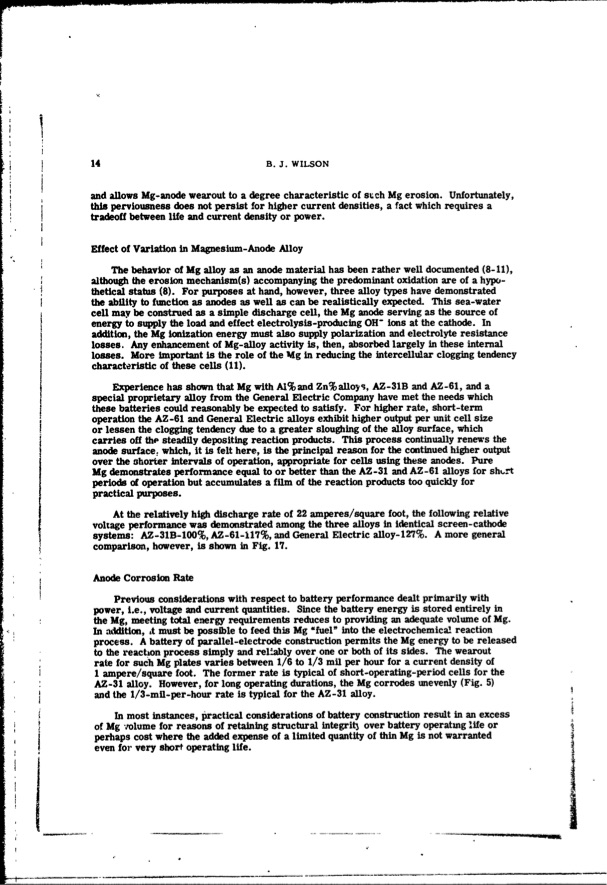
PDF Publication Title:
Text from PDF Page: 017
I 14 B. J. WILSON and allows Mg-anode wearout to a degree characteristic of such Mg erosion. Unfortunately, this perviousness does not persist for higher current densities, a fact which requires a tradeoff between life and current density or power. Effect of Variation in Magnesium-Anode Alloy The behavior of Mg alloy as an anode material has been rather well documented (8-11), although the erosion mechanism(s) accompanying the predominant oxidation are of a hypo- thetical status (8). For purposes at hand, however, three alloy types have demonstrated the ability to function as anodes as well as can be realistically expected. This sea-water cell may be construed as a simple discharge cell, the Mg anode serving as the source of energy to supply the load and effect electrolysis-producing OH" ions at the cathode. In addition, the Mg ionization energy must also supply polarization and electrolyte resistance losses. Any enhancement of Mg-alloy activity is, then, absorbed largely in these internal losses. Morea important is the role of the Mg in reducing the intercellular clogging tendency characteristic of these cells (11). ExperiencehasshownthatMgwithAlandZnalloys,AZ-31BandAZ-61,anda special proprietary alloy from the General Electric Company have met the needs which these batteries could reasonably be expected to satisfy. For higher rate, short-term operation the AZ-61 and General Electric alloys exhibit higher output per unit cell size or lessen the clogging tendency due to a greater sloughing of the alloy surface, which carries off th, steadily depositing reaction products. This process continually renews the anode surface, which, it is felt here, is the principal reason for the continued higher output over the shorter intervals of operation, appropriate for cells using these anodes. Pure Mg demonstrates performance equal to or better than the AZ-31 and AZ-61 alloys for sht.rt periods of operation but accumulates a film of the reaction products too quickly for practical purposes. At the relatively high discharge rate of 22 amperes/square foot, the following relative voltage performance was demonstrated among the three alloys in identical screen-cathode systems: AZ-31B-100%, AZ-61-117%, and General Electric alloy-127%. A more general comparison, however, is shown in Fig. 17. Anode Corrosion Rate Previous considerations with respect to battery performance dealt primarily with power, i.e., voltage and current quantities. Since the battery energy is stored entirely in the Mg, meeting total energy requirements reduces to providing an adequate volume of Mg. In addition, Atmust be possible to feed this Mg "fuel" into the electrochemica! reaction process. A battery of parallel-electrode construction permits the Mg energy to be released to the reaction process simply and reliably over one or both of its sides. The wearout rate for such Mg plates varies between 1/6 to 1/3 mil per hour for a current density of 1 ampere/square foot. The former rate is typical of short-operating-period cells for the AZ-31 alloy. However, for long operating durations, the Mg corrodes unevenly (Fig. 5) and the 1/3-mil-per-hour rate is typical for the AZ-31 alloy. In most instances, practical considerations of battery construction result in an excess of Mg -olume for reasons of retaining structural integrit3 over battery operating life or perhaps cost where the added expense of a limited quantity of thin Mg is not warranted even for very short operating life. IiPDF Image | INERT-CATHODE SEA-WATER BATTERY

PDF Search Title:
INERT-CATHODE SEA-WATER BATTERYOriginal File Name Searched:
AD0673399.pdfDIY PDF Search: Google It | Yahoo | Bing
Product and Development Focus for Salgenx
Redox Flow Battery Technology: With the advent of the new USA tax credits for producing and selling batteries ($35/kW) we are focussing on a simple flow battery using shipping containers as the modular electrolyte storage units with tax credits up to $140,000 per system. Our main focus is on the salt battery. This battery can be used for both thermal and electrical storage applications. We call it the Cogeneration Battery or Cogen Battery. One project is converting salt (brine) based water conditioners to simultaneously produce power. In addition, there are many opportunities to extract Lithium from brine (salt lakes, groundwater, and producer water).Salt water or brine are huge sources for lithium. Most of the worlds lithium is acquired from a brine source. It's even in seawater in a low concentration. Brine is also a byproduct of huge powerplants, which can now use that as an electrolyte and a huge flow battery (which allows storage at the source).We welcome any business and equipment inquiries, as well as licensing our flow battery manufacturing.| CONTACT TEL: 608-238-6001 Email: greg@salgenx.com | RSS | AMP |